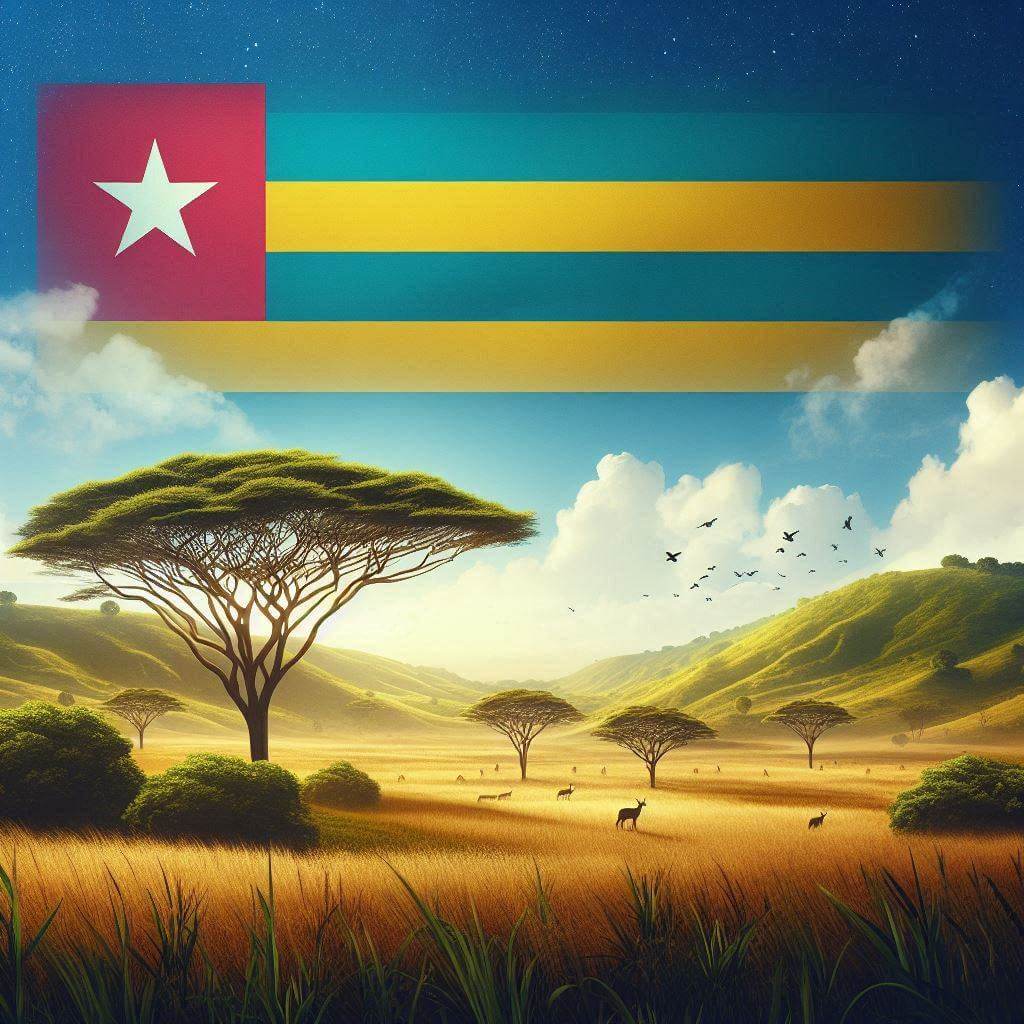The flag of Togo features a striking design of five horizontal stripes alternating between green and yellow, with a red canton in the upper hoist-side corner containing a white five-pointed star. This vibrant combination of colors and symbols encapsulates the nation's history, aspirations, and cultural identity.
Togo information
| National Flag Day | April 27 |
| Sovereign state | Yes |
| Official name | Togo |
| Capital | Lomé |
| Population | 8,278,724 |
| Area | 56,785 km² |
| Currency | West African CFA franc (XOF) |
| Language | French, Ewe, Kabye |
| Continent | Africa |
| Region | West Africa |
| Subregion | — |
| Borders | Burkina Faso, Benin, Ghana |
| Timezone | Greenwich Mean Time (GMT) UTC±0 |
| Calling code | +228 |
| Top-level domain | .tg |
History of the Togolese Flag
 The current flag of Togo was officially adopted on April 27, 1960, coinciding with the country's independence from French colonial rule. The design was created by artist Paul Ahyi and was chosen to represent the newly independent nation's identity and values. Despite a brief period of change during the military coup in 1963, when a different flag was used, the original design was reinstated in 1964 and has remained unchanged since then.
The current flag of Togo was officially adopted on April 27, 1960, coinciding with the country's independence from French colonial rule. The design was created by artist Paul Ahyi and was chosen to represent the newly independent nation's identity and values. Despite a brief period of change during the military coup in 1963, when a different flag was used, the original design was reinstated in 1964 and has remained unchanged since then.
Symbolism and Design of the Togolese Flag
Each element of the Togolese flag carries significant symbolic meaning:
- The green stripes represent agriculture, forestry, and the hope for a prosperous future. They symbolize Togo's natural resources and the importance of agriculture to the country's economy.
- The yellow stripes signify the mining wealth of Togo, particularly its phosphate deposits, which are crucial to the nation's economy.
- The red canton in the upper left corner symbolizes the blood shed for independence, as well as the nation's commitment to defending its freedom.
- The white star within the red canton represents hope, life, and purity. It also symbolizes the unity of the Togolese people and their aspiration for peace.
The five stripes are thought to represent the five regions of Togo: Maritime, Plateaux, Centrale, Kara, and Savanes, emphasizing national unity across diverse geographical areas.
Usage and Significance of the Togolese Flag
 The flag of Togo is a powerful symbol of national identity and pride. It is prominently displayed on government buildings, schools, and during national celebrations such as Independence Day on April 27th. The flag serves as a unifying emblem, reminding Togolese citizens of their shared history, cultural heritage, and collective aspirations for the future.
The flag of Togo is a powerful symbol of national identity and pride. It is prominently displayed on government buildings, schools, and during national celebrations such as Independence Day on April 27th. The flag serves as a unifying emblem, reminding Togolese citizens of their shared history, cultural heritage, and collective aspirations for the future.
In international contexts, the Togolese flag represents the country at diplomatic events, United Nations gatherings, and global sports competitions. It embodies Togo's sovereignty and its place in the community of nations.
Interesting Facts About the Togolese Flag
- The design of the Togolese flag was inspired by the flag of Liberia, which in turn was inspired by the flag of the United States, reflecting a chain of influence in flag design across African nations.
- The flag's creator, Paul Ahyi, was a renowned Togolese artist who also designed the coat of arms of Togo and created numerous public art pieces throughout the country.
- The proportions of the Togolese flag are 1:1.618, adhering to the golden ratio, which is believed to be aesthetically pleasing to the eye.
- The exact shades of colors used in the flag are specified by law to ensure consistency in all official representations.
- During the brief period of military rule in 1963, a different flag featuring two red stars was used, but it was quickly replaced with the original design in 1964.